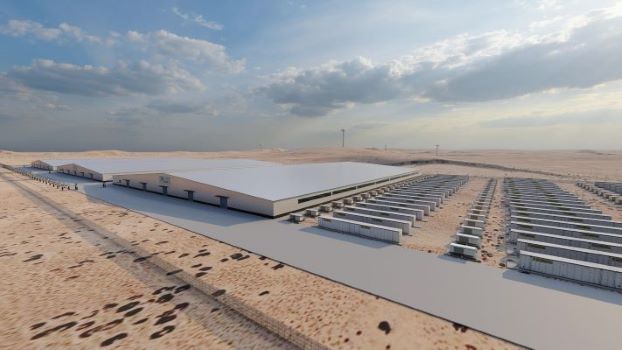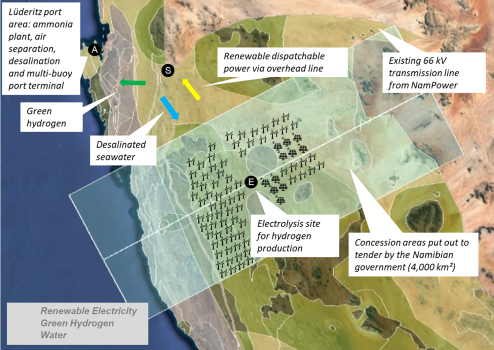Green hydrogen
Hyphen Hydrogen Energy - Namibia
|
Basic description Hyphen Hydrogen Energy is a Namibian company established with the objective of developing, constructing and operating green hydrogen production facilities in Namibia for international, regional and domestic markets. The company was selected in November 2021 by the Namibian government to develop a large-scale vertically integrated greenfield green hydrogen project in the Tsau//Khaeb national park. The allocated area is owned by the government and co-located with the deep-water port of Lüderitz. The project consists of around 5 gigawatts (GW) wind and solar energy capacity vertically integrated with 3 GW electrolyser capacity, capable of producing around 300 kilotonnes of green hydrogen. This is to be used as an input to produce around 1.7 million tonnes of ammonia per year, representing over 1% of the current worldwide ammonia production. Hyphen estimates the total project cost to be around USD 10 billion. The project will follow a two-stage process. Phase one will require a total investment of around USD 4.5 billion to produce around 0.7 million tonnes of ammonia. An implementation agreement with the government on the detailed engineering is expected by end 2022, targeting financial close in 2024 and commercial production starting in 2026. Phase two is expected to be commissioned by end 2028, with production reaching around 300 kilotonnes per year of green hydrogen from 2029 onwards. |
 |
 |
Project rationale In August 2021, the Government of Namibia issued a request for proposal to develop green hydrogen production facilities in two land pieces in the Kharas region. This was part of the Southern Corridor Development Initiative (SCDI), the umbrella programme for the development of a green hydrogen industry in southern Namibia. The selected location benefits from one of the highest resource potentials worldwide for the combined production of wind and solar-based electricity. Namibia’s ambition to develop green hydrogen offers a double opportunity to deploy renewable energy at scale, facilitating both energy independence and green industrialisation-led economic growth in the country. The project’s estimated capital cost is almost equivalent to Namibia’s gross domestic product, underscoring its strategic importance for the country. Hyphen’s project is expected to create around 15 000 construction jobs over the construction period of 4 to 5 years. Once fully developed, it will employ approximately 3 000 people. At least 90% of these jobs are expected to be taken by Namibian citizens. As part of the project, Hyphen will develop a common user infrastructure (CUI) encompassing a desalination plant, water pipelines, electricity transmission lines, hydrogen pipelines, and an ammonia storage and export facility. The establishment of the CUI by Hyphen will benefit all subsequent projects, facilitating the scale-up of hydrogen production in the SCDI project portfolio and potentially leading to up to 3 million tonnes of green hydrogen production per annum. This represents one-fifth of Namibia’s total green hydrogen production potential of 15 million tonnes per year, which is between 5% and 10% of the expected global hydrogen demand in 2030. |
Governance
Hyphen was formed as a partnership between its two shareholders, Nicholas Holdings and Enertrag. The governance of Hyphen’s project in Namibia will rely on a public-private partnership, although it is not yet fully defined, as financial closure is expected in 2024. The government, either directly or via its Welwitschia Sovereign Fund, has proposed to be a strategic equity partner in all green hydrogen projects in Namibia, targeting a 24% equity shareholding in Hyphen’s project.
The Government of Namibia was responsible for designing and administering the tendering of the first land parcels in the SCDI. The tender was undertaken in an open and transparent manner, with a request for information having been initiated by the government ahead of the tender process. In evaluating the tender submissions, the government drew on international expertise from two advisors appointed by the European Union Global Technical Assistance Facility on Sustainable Energy and the United States Department of Energy.
The CUI, to be implemented in phases, will be designed to support the long-term production potential of the SCDI of 3 million tonnes per annum of green hydrogen, the equivalent of ten Hyphen projects. The CUI is intended to be operated on a system ensuring access, transparency, and equal treatment for all future projects.
To drive implementation, the government has established the Green Hydrogen Council, comprising key ministers responsible for the development and implementation of Hyphen’s project and Namibia’s broader green hydrogen strategy.
Business model
Hyphen’s business model in Namibia is market-based, relying on the production of green hydrogen-based chemicals (such as ammonia) and the sale of green electricity. The choice of ammonia is driven by the maturity of its value chain and the consequent viability to produce, store, transport and consume it as a globally traded product.
Given the size of the project and the low domestic needs for green hydrogen and ammonia, Europe and East Asia are likely to be the key drivers for demand. Negotiations with potential off-takers are ongoing. The first projects will be costlier while the green hydrogen industry is at the beginning of the learning curve, but access to low-cost renewable energy sources and the CUI should contribute to its longer-term competitiveness at the international level.
As additional projects in the SCDI are brought online, Namibia could also benefit from further regional integration. For instance, a better-integrated regional grid can help South Africa, the largest electricity consumer in the region, where more than 80% of electricity generation is based on coal, achieve its ambitious decarbonisation targets. Green hydrogen projects in Namibia will lead to surplus electricity generation which cannot be absorbed by the domestic grid. Given that South Africa has a large industrial sector that could potentially use green hydrogen to achieve its decarbonisation goals, Namibian green hydrogen and electricity could be exported there. This would generate additional revenues, improve profitability of Namibia’s green hydrogen industry, and foster regional decarbonisation.
In the longer term, access to low-cost renewable electricity and hydrogen in Namibia can be used to develop fossil fuel-free industry and transport sectors, for instance, mining and processing of zinc and other minerals or the conversion of diesel locomotives.
Enabling market conditions and de-risking investment
Government support has been a critical enabler for the development of Hyphen’s large-scale project. The government has defined its ambition, set a clear strategy for the development of its green hydrogen industry, initiated the request for proposal, and is providing the land. A clear master plan fosters confidence in the project development despite it being a complex cross-ministerial project. In addition, the government facilitated an early stakeholder engagement to address the environmental, social and governance issues.
Access to infrastructure is also a major enabler, as the economic viability of Hyphen’s project requires the use of desalinated water, power transmission lines to sell electricity, green hydrogen pipelines, storage of green ammonia and a deep-water port. As infrastructure development can potentially delay the project development, the CUI design and the vertical integration of the Hyphen project have ensured its attractiveness to investors.
Although the project’s business model relies on the existing ammonia market, it is expected that current and future interventions will drive the adoption of green hydrogen products. These measures are likely to include carbon pricing and minimum blending requirements of green hydrogen in the ammonia production process. Contracts for difference could also help ensure competitiveness of the project, independent of the variation of competing fossil fuel markets (such as in Germany’s H2Global programme). Carbon credits could also provide an additional revenue source.
Financing
Although SCDI is a government-led process, public financing of such large projects is constrained by the size of the Namibian economy. Thus, sound financial structuring is critical to avoid debt financing obligations for the Namibian government.
Hyphen’s project is capital-intensive and will have a substantial balance sheet impact for the project developers and equity investors. The government targets a 24% equity shareholding in Hyphen’s project; as there is other requirement for local equity shareholder, this allows new international actors to acquire stakes. Still, the lion’s share of the financing needs to come from debt instruments.
The local debt market is not sufficiently developed and there is no possibility to access local currency debt instruments at the scale of Hyphen’s project. However, the vertical integration of the project and the sale of ammonia on the international market reduces currency risk. Moreover, there is substantial interest from Development Finance Institutions (DFIs) and commercial lenders in the potential for blended finance solutions to help the project reach financial close.
Related Documents